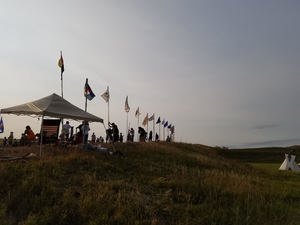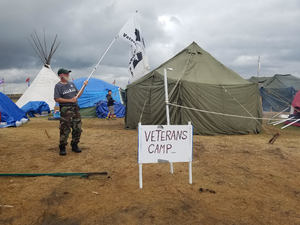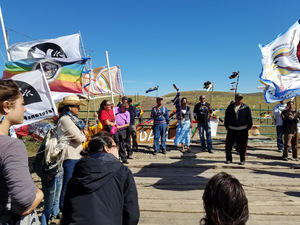September 23, 2016

by Craig Wood
The 440 mile ride from from Minneapolis, Minnesota to the Standing Rock Indian Reservation encampment in North Dakota was smooth and pleasant - well, there were some cops.
A gruff policeman we met at a gas station west of Fargo was helpful with directions, but had nothing good to say about thousands of entrenched protestors at Standing Rock showing opposition to the controversial North Dakota Access Pipeline (DAPL). He warned us about area volatility and made a sour face about "third-world living conditions" at the encampment.
We took the famed Lewis and Clark Highway (1806) south from Bismarck and were stopped at a roadblock about 20 minutes later by nearly a dozen nation guardsmen wearing combat gear. One asked "do you know what's going on down the road?" I nodded and he waved us through after seeing donated supplies in the back of the truck and cautioning us about pedestrians walking along the side the road. This was not the friendly tourist information booth I recalled from my childhood when my sister and I rode out west with my mom and dad in a station wagon.

From there it was a another 20 minute drive to Standing Rock; an easygoing wend through grassy hills that provides frequent glimpses of a slow-moving Missouri River on the left and tranquil vistas punctuated by gumbo buttes on the right. When you see the sign Little Heart Pond, you're about fifteen minutes away from Sacred Stone Camp. The encampment is just north of the Cannonball River - you'll see the tents.
Two volunteers greeted us at the main gate and directed us toward a supply tent to drop off our gifts - food, water, toilet paper and assorted tampons of various sizes. Volunteer Lance RedHawk from Lacrosse, Wisconsin mentioned how surprised he was at the amount of donations that poured in a daily basis. Another volunteer though mentioned that supplies sometimes run low.
With the cold season coming there's new a push to winterize was the camp was. Camp elders were concentrating on procuring tools, firewood, items from hardware stores and constructions supplies. Families along with lone tribal members from much warmer climates have already committed to staying on in a state that routinely posts -50 below zero windchill temperatures.
Martin Bates of La Forte, Colorado recently returned to Standing Rock with two large army surplus tents after raising about $ 2,500.00 dollars on the GoFundMe site. Bates said the encampment grew noticeably in size since his last visit in late August and estimated that up to 300 tribes may already be represented in one way or another in this peaceful action - some from as far away as South America. The encampment population including visitors, is estimated to be between 5 to 7 thousand according to volunteers at the main gate - more people come on weekends.
With thousands of people camped out the outdoor kitchen is busy and someone is always chopping wood. One volunteer said that at least a thousand people are served at every meal. Tribal members from Maine brought moose meat that day so we had moose soup and moose meat slices for supper. The next day spam tacos were one of the options for lunch.
There's a communal gathering after supper - elders speak, stories are told, music is played and dances are danced. Members of a tribe in Ecuador who believe they are descendants of jaguars talked about how a thousand of their members (including children) stopped an oil company from drilling in their country.
An interchange of ideas about protecting water is the ongoing discussion that runs through camp day and night. You can go from a conversation about how drilling was stopped in Nebraska to the lawfully depth a tool can dig into the earth in a few steps. A tent to handle ongoing and new legal concerns was set up on September 15.
Sleeping out is safe and reports of alcohol or drug use are rare. Those caught are directed to the main gate. Drumming along with intermittent barking-dog or wolf cries may go on late so earplugs are recommended for light sleepers.

There's another communal gathering in the morning where camp concerns and events are planned. It's also an open-mike for poets, musicians or anyone else who wants to participate in the time-honored tradition of talking out loud in front of others. Joan Baez sang the day before.
Elders also took turns at the microphone reminding the after-breakfast crowd of the seriousness of their clean water mission. A woman and man both talked earnestly about the importance of not wearing sexually suggestive clothing.
The woman recommended appropriate dresses and both urged everyone to stay focused on issues and participate in everyday communal camp work. "Volunteer at the kitchen - chop wood - if you see litter on the ground, pick it up -- this isn't a San Francisco hippie party" said one elder.
Later that day a group of about 400 marched at least a mile down HWY #1806 to an area
where construction was halted after activists attempted to stop work on land they believed to be sacred and part of an ancestral burial ground. An ugly scene ensued including the use of dogs by a security company on protestors.
The march was prompted by a tip that a company who owns the earth-moving equipment was going to move them that day and members of the encampment wanted to be on hand to see and document the condition of the machines in case the company later claimed there was "excessive damage" by disgruntled activists.
No machines were moved that day. So - the group walked back to the encampment pausing a couple times to have small ceremonies and drop tobacco on the land.
24 hours isn't a lot of time, but it may be enough if you keep your eyes and ears open in a place the BBC has called "the largest gathering of Native Americans in over a hundred years." You'll never forget the sight of a Native American girl standing in the sand with a small drum singing to the Cannonball River.
The legal issues are too many and complex to go into - at least for me. For now, serious-minded people are invited to participate in solidarity with those who care about the environment and don't want to gamble with the purity of drinking water.
Standing Rock is not for simple-lifers looking for free food and a place to crash or fashion conscious hipsters looking to be seen. It may be considered bad form to end a story with a
quote from someone else, but seriously, the camp elder was right - "This isn't a San Francisco hippie party."

